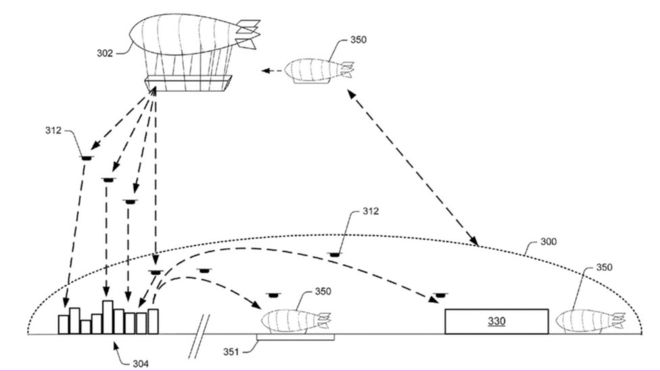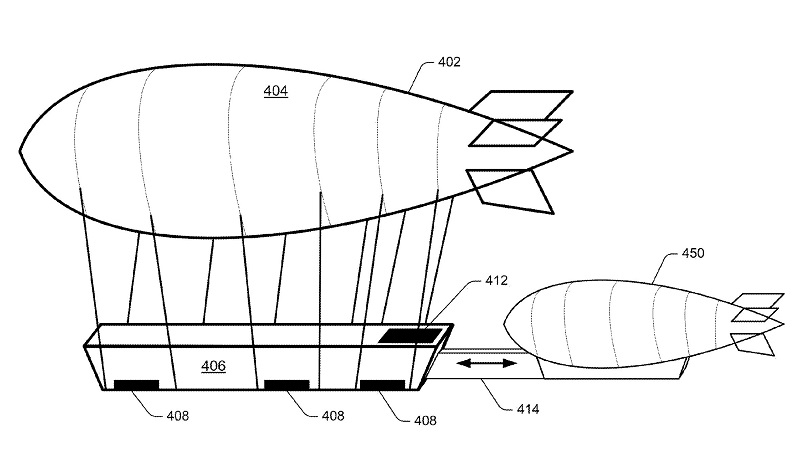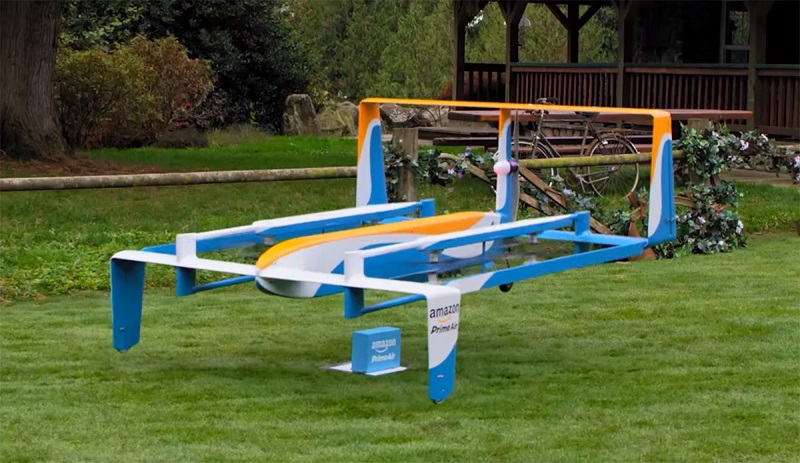Amazon flying warehouses
In December 2016, it came to light that the online retail giant Amazon had filed a patent for massive flying warehouses that could be used to assist and house a fleet of delivery drones.
Originally filed in 2014, the patent refers to the warehouses as ‘airborne fulfilment centres’ (AFCs) kept aloft by airships.
Although Amazon has refused to comment on the patent, the details involve AFCs being stationed above major cities, storing items for rapid delivery at peak times. Drones dispatched from the AFCs would glide downwards to a user-specified delivery location rather than fly, using little-to-no power. The drones are said to be capable of cruising and hovering at altitudes of up to 14,000 m (45,000 ft).
A series of ‘shuttles’ are also mentioned in the patent. It is thought that these would replenish the larger AFCs with stock and fuel, or provide transit for workers.
Areas where lots of merchandise is sold but there is difficult access, such as sporting arenas or music festivals, are highlighted as being places where AFCs could be of most use.
Despite Amazon being reluctant to comment, it has been widely reported that they are developing delivery drone capabilities. A video released in 2015 showed the latest versions of their flying robots undergoing testing. Packages weighing up to 2.2 kg (5 lb) were reported as being deliverable in 30 minutes using drones capable of travelling up to 15 miles.
[edit] Find out more
[edit] Related articles on Designing Buildings Wiki
Featured articles and news
Key points for construction at a glance with industry reactions.
Functionality, visibility and sustainability
The simpler approach to specification.
Architects, architecture, buildings, and inspiration in film
The close ties between makers and the movies, with our long list of suggested viewing.
SELECT three-point plan for action issued to MSPs
Call for Scottish regulation, green skills and recognition of electrotechnical industry as part of a manifesto for Scottish Parliamentary elections.
UCEM becomes the University of the Built Environment
Major milestone in its 106-year history, follows recent merger with London School of Architecture (LSE).
Professional practical experience for Architects in training
The long process to transform the nature of education and professional practical experience in the Architecture profession following recent reports.
A people-first approach to retrofit
Moving away from the destructive paradigm of fabric-first.
International Electrician Day, 10 June 2025
Celebrating the role of electrical engineers from André-Marie Amperè, today and for the future.
New guide for clients launched at Houses of Parliament
'There has never been a more important time for clients to step up and ...ask the right questions'
The impact of recycled slate tiles
Innovation across the decades.
EPC changes for existing buildings
Changes and their context as the new RdSAP methodology comes into use from 15 June.
Skills England publishes Sector skills needs assessments
Priority areas relating to the built environment highlighted and described in brief.
BSRIA HVAC Market Watch - May 2025 Edition
Heat Pump Market Outlook: Policy, Performance & Refrigerant Trends for 2025–2028.
Committing to EDI in construction with CIOB
Built Environment professional bodies deepen commitment to EDI with two new signatories: CIAT and CICES.
Government Grenfell progress report at a glance
Line by line recomendation overview, with links to more details.
An engaging and lively review of his professional life.
Sustainable heating for listed buildings
A problem that needs to be approached intelligently.
50th Golden anniversary ECA Edmundson apprentice award
Deadline for entries has been extended to Friday 27 June, so don't miss out!
CIAT at the London Festival of Architecture
Designing for Everyone: Breaking Barriers in Inclusive Architecture.
Mixed reactions to apprenticeship and skills reform 2025
A 'welcome shift' for some and a 'backwards step' for others.





























